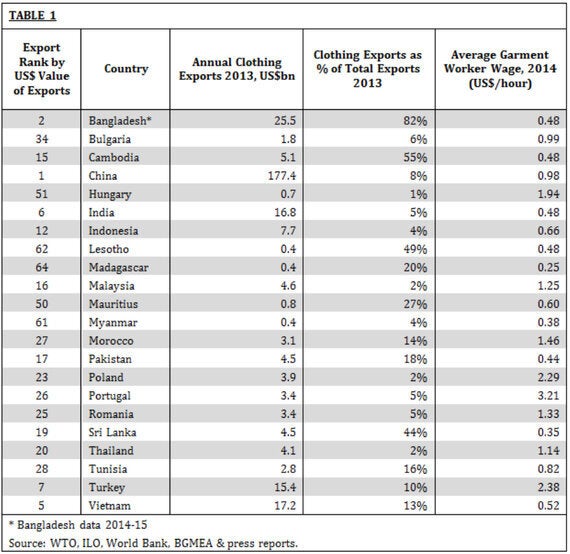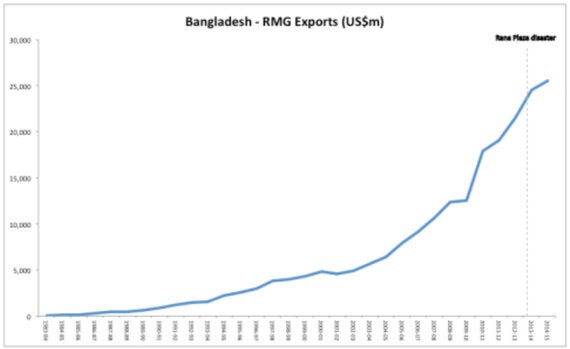After the tragedy of Rana Plaza in Bangladesh we have only seen piecemeal change for developing world garment workers - token pay rise announcements after accidents and as a result of protests.
Why do we not see blanket, tangible reform?
Is there any real prospect of change? Actually, some change is possible, but not for philanthropic or empathic reasons. Customers in developed markets will only change when they realise what their clothes genuinely cost them - both monetarily and environmentally.
We encourage consumers to 'Look At the Label' and 'Wear It Again'.
So why aren't consumers outraged sufficiently to take action? One reason is that people have become desensitised to tragic news events. Our daily newsfeed is full of distressing and alarming crises. However none really drives us to take action or demand change. Rather we shake our heads in dismay for a moment and then return to our daily lives.
Another reason is that ultimately few people are willing to change their behavior for what does not affect them directly. In this age of immediate gratification it is difficult to imagine most people foregoing the opportunity to buy a desired item of clothing out of concern for a generally anonymous, faceless garment manufacturer somewhere in the developing world.
And even if consumers were outraged sufficiently to protest, the challenge is that the focus of any ire is not singular. Quite simply, the market - both from a retailer and factory supplier perspective - is too fragmented.
And without knowing precisely who to blame an Arab Spring-type, transformational movement is difficult to initiate.
Are you really getting what you pay for? Look At the Label
A starting point is needed and one which provides a better understanding as to why garment manufacturing exploits the poor in developing nations.
The picture becomes clearer when one looks at the evolution of the garment industry from local to global.
It begins with China, which was a country full of untapped, unskilled, cheap labour confined to its agricultural sector. Under economic reform, which began in the late 1970s under Deng Xiaoping, swathes of this available labour gradually migrated to cities to work in industry.
In tandem with this migration, the developed world transferred much of its production to this low-cost labour region. This led to the demise of manufacturing in traditional Western markets and to China, over time, becoming the factory of the world.
In recent years, however, and as China's economy has become more developed and sophisticated, wage costs there have risen.
This has presented an opportunity to other markets which have similarly large available labour in rural communities and which can be transferred to cities to undertake low skilled manufacturing jobs. This large flow of labour is also likely to continue given favourable demographics in many developing markets, i.e. constituent countries in these regions tend to have significant and growing young populations.
Where garment manufacturing is concerned, peripheral Asian markets, Central and Eastern Europe and now progressively Africa all present potentially cheaper options when compared with China.
To all intents and purposes, fashion brands have an abundance of choice when it comes to cheap garment manufacturing hubs.
What also needs to be borne in mind is that clothes are commodities which can be produced largely by anyone anywhere.
That recent fashion design trends have also leaned towards the simple and minimalist underlines this fact. Rarely now do we see elaborate, complicated constructions for everyday wear.
Basically clothes are not unique products created via application of some special skill, such as with aircraft construction.
Since the skill required is largely ubiquitous, the only point of differentiation is cost. Thus factories across these countries compete to offer the lowest possible cost.
And competition is fierce, especially for those in a bid to secure flagship brands. Indeed such brands have substantial buying/negotiating power, both from a volume and brand perspective. It is worth noting that often one large parent company can own a number of well-recognised, individual brands. In this instance the parent company will look to negotiate and secure low costs across its stable of brands. Factories faced with such powerful customers will have no choice but to compete in keeping costs as low as possible in order to secure business.
Governments also need to be taken into account here. Where economies rely on an industry, the likelihood of transforming, government-led initiatives (e.g. proper pay and/or improved working conditions) is low given it would make that industry less competitive.
For information Table 1 below sets out detail for a number of sizeable and cheap garment manufacturing countries - including where they rank globally in terms of value of ready-made garment (RMG) exports, those exports as a percentage of the country's total exports and respective average hourly garment worker wages.

After China, Bangladesh now ranks as the world's second largest exporter of RMGs in US dollar value terms. It exports over US$25bn worth of RMGs accounting for 82% of the country's total exports. The industry employs 4m people, in a country of 31m households.
A number of other countries' economies are similarly reliant on garment manufacturing - Cambodia (55%), Lesotho (49%), Sri Lanka (44%), Madagascar (20%), Mauritius (27%), Pakistan (18%), Tunisia (16%), Morocco (14%), Vietnam (13%).
It is perhaps no surprise that these countries also have some of the lowest garment worker wage rates.
All of these markets, plus other developing peers, are competing to make our clothes. Since they can only really compete on cost competition becomes a race to the bottom.
If we again take Bangladesh as an example - garment manufacturing has become intrinsic to this country's economic survival.
Bangladesh has spent the last 30 years developing this industry. Over that period the industry has grown by an average 20% per year in US dollar value terms.
Even after the Rana Plaza tragedy Bangladesh's RMG exports grew (see chart below). Indeed its garment manufacturing industry is expected to grow further.
A report by McKinsey conducted, also after the Rana Plaza disaster, and in which 20 chief purchasing officers in the US and Europe were surveyed (responsible collectively for US$39bn of sourcing) stated that Bangladesh would remain the most important alternative apparel sourcing market after China. Bangladesh was also forecast to grow through to 2020. Of the CPOs surveyed 86% cited labour cost advantages as one of their three most important reasons for sourcing in Bangladesh.

Raising costs either through wage hikes or factory improvements would likely put Bangladeshi factories at a competitive disadvantage versus other markets which are competing for its business.
An example of this is the failure to fully implement garment worker wage hikes. In December 2013 the Bangladeshi government imposed a 77% increase in the garment worker monthly minimum wage to US$68 (versus an estimated living wage of around US$245). However, according to the FT and other press reports, almost 40% of factories in Dhaka alone have failed to comply. In addition HRW (Human Rights Watch) has reported intimidation of workers attempting to unionise.
In terms of working conditions NGOs have estimated a cost of US$3bn to raise safety conditions in Bangladeshi factories to adequate standards. This is a colossal cost and one that local factory owners will struggle to meet given falls in profitability, a weak currency, high inflation and high borrowing costs. To add these costs cannot be passed on to clothing companies because the end consumer is unwilling to pay.
And on an individual factory basis each would be subject to the same pressure. Any factory which did choose to stand aside from the norm to pay higher wages and deliver better working conditions would find itself at a competitive disadvantage not just versus foreign but also its country peers.
To this end Bangladesh and its factory owners are really between a rock and a hard place. And they are not alone. Its developing market competitors are faced with the same challenges.
The true price of fashion.
